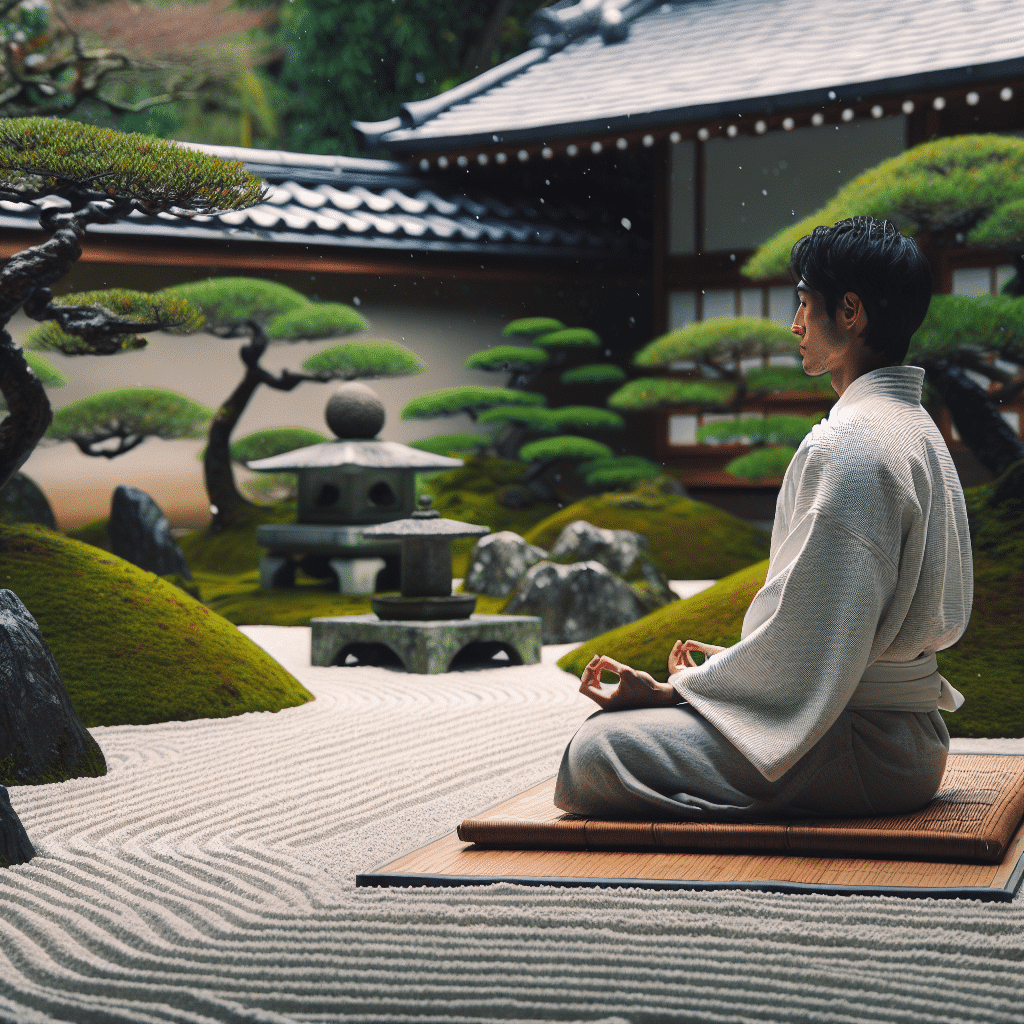
Discover the transformative power of Zen meditation in our latest blog post. Dive into the peaceful practice of this ancient tradition and learn how it can bring clarity, mindfulness, and a sense of inner stillness into your life. Whether you’re new to meditation or an experienced practitioner, this guide will provide valuable insights, practical tips, and techniques to enhance your Zen meditation practice. Join us on this journey of self-discovery and explore the profound benefits of Zen practices in cultivating a calm and centered mind. Start your meditation practice today and experience the serenity and tranquility that Zen meditation can bring.
Section 1: Preparing For Zen Meditation
Before embarking on your Zen meditation journey, it’s essential to prepare yourself mentally and physically for the practice. The preparation phase sets the foundation for a successful and fulfilling meditation experience. Here are some key steps to consider:
- Create a Sacred Space: Designate a quiet and clutter-free area in your home where you can practice meditation without distractions. Decorate it with minimalistic and calming elements, such as a meditation cushion, incense, or a soothing color scheme.
- Set the Right Time: Choose a time of day that works best for you, when you’re least likely to be disturbed. Early mornings are often preferred as the mind is fresh and calm after a good night’s sleep.
- Get Comfortable: Find a sitting position that allows you to be relaxed and upright. The traditional cross-legged posture, known as the lotus position, is commonly used in Zen meditation. However, if this is challenging for you, you can opt for a kneeling position or sit on a chair with your feet planted firmly on the ground.
- Focus on Breath Awareness: Take a few moments to settle into your chosen position and bring your attention to your breath. Notice the natural rhythm of your breath, allowing it to flow effortlessly in and out of your body. This simple act of breath awareness helps to quiet the mind and anchor you in the present moment.
- Set an Intention: Before diving into meditation, take a moment to set an intention for your practice. This can be as simple as cultivating inner peace, self-discovery, or a specific area of personal growth that you wish to explore.
By following these preparatory steps, you create a conducive environment for Zen meditation. Remember, the key is to approach your practice with an open mind, patience, and curiosity. As you embark on your Zen meditation journey, allow yourself to embrace the present moment and let go of any expectations or judgments. This will help you cultivate a deeper and more meaningful meditation experience.
Section 2: Getting Into Position
Once you have created a conducive environment and prepared yourself mentally for Zen meditation, the next step is to get into a comfortable and stable sitting position. While there are different sitting postures you can adopt, the lotus position is commonly used in Zen meditation. Here are some key considerations for getting into position:
- The Lotus Position: In the traditional lotus position, sit on the floor with your legs crossed and your feet resting on the opposite thighs. Keep your spine upright, allowing the natural curve of the back to support you. This posture promotes stability and helps maintain focus during meditation.
- Alternative Positions: If the lotus position is uncomfortable or not accessible for you, there are alternative sitting positions you can try. The half-lotus position involves crossing one leg over the opposite thigh while placing the other foot on the floor. Another option is to sit on a meditation cushion or bolster, with your legs crossed in front of you or kneeling on a mat or cushion.
- Chair Meditation: If sitting on the floor is challenging, you can also practice Zen meditation in a chair. Sit on the edge of a sturdy chair with your feet grounded on the floor. Maintain an upright posture, allowing your spine to be straight and relaxed.
- Comfort and Stability: Regardless of the sitting position, it’s crucial to find a balance between comfort and stability. Use cushions or bolsters to support your back and hips if needed. Ensure that your body is relaxed and free from tension.
Remember that the physical position you choose is primarily for supporting your meditation practice. It should allow you to be comfortable, stable, and grounded. The goal is to find a position that facilitates a sense of alertness and promotes a focused, yet relaxed state of mind.

Section 3: Practicing Breath Awareness
In Zen meditation, breath awareness plays a significant role in cultivating mindfulness and deepening your practice. By observing the breath, you can cultivate a state of focus and presence. Here are some key aspects to consider when practicing breath awareness:
- Find Your Anchor: Start by finding a comfortable position and bringing your attention to your breath. Choose a specific point of focus, such as the sensation of the breath at the nostrils or the rise and fall of the abdomen.
- Natural Breathing: Allow your breath to flow naturally without trying to control or manipulate it. Simply observe the breath as it goes in and out, without judgment or attachment to any particular pattern.
- Stay Present: As you bring your attention to the breath, you may notice that your mind starts to wander. This is natural and normal. When you become aware of your thoughts drifting away, gently redirect your focus back to the breath, without judgment or frustration.
- Observe Sensations: As you focus on the breath, notice the subtle sensations associated with breathing. Pay attention to the temperature, texture, and movement of the breath. Stay present and curious, exploring the breath with a sense of open awareness.
- Extend Your Awareness: As you continue practicing breath awareness, you can expand your awareness to include the body and the surrounding environment. Embrace a sense of interconnectedness and observe how the breath connects you to the present moment.
- Practice Nonjudgment: Throughout your breath awareness practice, maintain an attitude of nonjudgmental observation. Allow thoughts, emotions, and sensations to come and go without labeling them as good or bad. Embrace each moment with acceptance and gentle curiosity.
Remember, the purpose of practicing breath awareness is not to achieve a specific outcome or experience, but rather to cultivate a heightened state of mindfulness and presence. By anchoring your attention to the breath, you can nurture a sense of inner calm and develop a deeper connection with yourself and the present moment.
Section 4: Working with the Distractions
During Zen meditation, it’s common to encounter distractions that can disrupt your focus and derail your practice. However, the aim is not to eliminate these distractions but to develop a skillful response to them. Here are some strategies to work with distractions:
- Nonattachment: Cultivate an attitude of nonattachment towards distractions. Instead of resisting or pushing away distractions, acknowledge their presence and gently let them go. Release any judgments or frustrations that arise.
- Gentle Redirecting: When you notice your mind wandering off, gently and without judgment bring your attention back to the breath or your chosen point of focus. Use this redirection as an opportunity to strengthen your concentration and resilience.
- Labeling: Recognize distractions as mental events and label them neutrally. For example, if a thought arises, silently label it as “thinking” before returning to the breath. This technique helps you create distance from distractions and maintain focus.
- Integrate Distractions: In some cases, distractions may persist and resist your efforts to let them go. Instead of fighting against them, integrate them into your meditation. Allow distracting thoughts, emotions, or sounds to become part of your field of awareness without getting caught up in them.
- Patience and Persistence: It’s important to approach distractions with patience and persistence. Understand that distractions are a normal part of the meditation process, and with consistent practice, your ability to navigate them will improve over time.
Remember, the key is not to become frustrated or discouraged by distractions. Instead, view them as opportunities for growth and deepening your meditation practice. By developing a skillful relationship with distractions, you can cultivate greater clarity, focus, and insight in your Zen meditation.
Section 5: Sustaining the State of Meditation
Sustaining the state of meditation in Zen practice involves maintaining presence and mindfulness throughout your sitting. Here are some key aspects to consider:
- Posture: Continue to prioritize an upright and stable posture during your meditation to support alertness and focus.
- Breath: Maintain awareness of your breath, using it as an anchor to bring you back to the present moment whenever your mind wanders.
- Non-Striving: Release the need to achieve any particular state or outcome in meditation. Instead, cultivate an attitude of non-striving and embrace the practice as it unfolds naturally.
- Open Awareness: Expand your awareness to include the entirety of your experience, embracing sounds, bodily sensations, and thoughts as they arise. Allow them to come and go without getting caught up in them.
- Patience: Cultivate patience as you sit in meditation, staying present and accepting whatever arises, whether it is calm or busy, pleasant or uncomfortable.
- Integration into Daily Life: Extend the benefits of your meditation practice into your daily life by bringing mindfulness and presence into your activities, relationships, and interactions.
Remember, sustaining the state of meditation is not about clinging to a particular experience but about cultivating a quality of presence and awareness in each moment. As you continue to practice Zen meditation, you will deepen your ability to stay present and carry the benefits of meditation into all aspects of your life.

Conclusion
Zen meditation offers a powerful practice for cultivating presence, mindfulness, and inner peace. By incorporating the principles and techniques of Zen into your meditation practice, you can deepen your experience and reap the numerous benefits for your physical, mental, and emotional well-being.
In this blog post, we explored the foundational aspects of Zen meditation, such as preparing for meditation, getting into position, practicing breath awareness, working with distractions, and sustaining the state of meditation. By incorporating these practices into your daily life, you can develop a deeper understanding of yourself, cultivate calm and clarity, and enhance your overall well-being.
Remember, the key to Zen meditation is consistency and continuity. With regular practice and dedication, you can experience profound transformation and growth in your life. So, go forth and embark on this beautiful journey of self-discovery and inner peace through Zen meditation.






